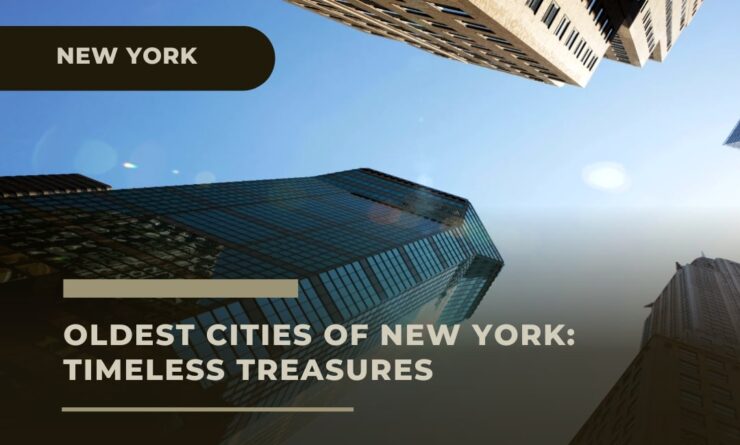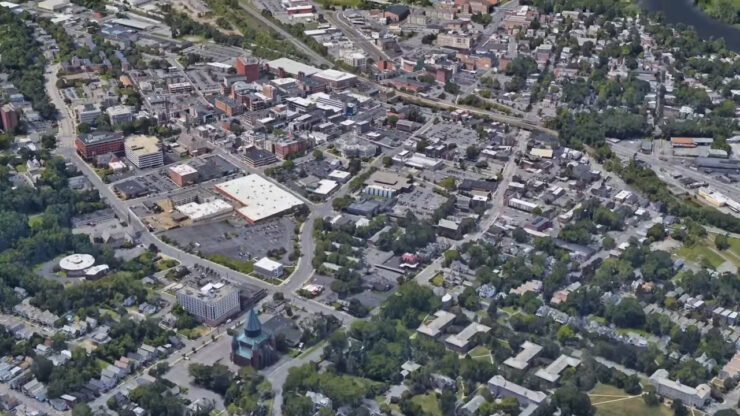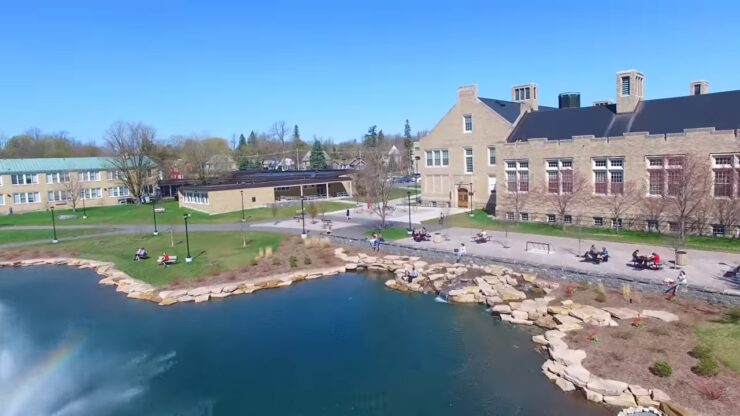When the name “New York” is mentioned, most people’s minds instinctively conjure up images of the bustling metropolis that is New York City. And rightly so, for the city has solidified its status as a global hub, wielding immense influence not only over its own state and region but also across the nation and the world.
However, what many may find surprising is the rich heritage and allure that upstate New York possesses. In this article, we embark on a bird’s eye tour of some of the oldest cities in the state, showcasing their historical significance as founding communities of one of America’s original 13 states.
Albany, 1614 (population 99,224):

Nestled along the western bank of the Hudson River, approximately 152 miles north of New York City, lies Albany, the capital of New York. Its roots trace back to 1609 when Henry Hudson explored the area and claimed it for the Netherlands. Initially established as a Dutch fur trading post named Beverwijck, Albany was later renamed to honor a British duke after the Dutch ceded control to the British in 1674.
Throughout history, Albany played a vital role in shaping the destiny of the nation, from being the birthplace of Ben Franklin’s Albany Plan of Union during the American Revolution to the imprisonment of British
loyalists and prisoners of war. With a thriving economy built on industries like iron processing, publishing, and banking, Albany cemented its position as a major industrial center of the Northeast when it became connected to the Great Lakes through the Erie Canal in 1825.
For a breathtaking bird’s-eye view of modern-day Albany, one must ascend to the top of the towering Erastus Corning II tower, standing tall at an impressive 589 feet. History enthusiasts will find solace in the New York State Museum, boasting a remarkable collection of 4 million natural specimens and 8 million artifacts from human culture.
For those with a penchant for the arts, The Egg Performing Arts Center, with its sculptural design, stands as a testament to Albany’s vibrant creative scene. Nature enthusiasts can indulge in a historian-narrated cruise along the Hudson River or explore the diverse flora of Washington Park, especially during the Tulip Festival held in the spring.
New York City, 1624 (population 8,804,190):

Undoubtedly, New York City claims its rightful place as the largest city in the United States, with an astounding population of over 8.8 million people. Boasting unparalleled ethnic diversity, with more than 800 languages spoken within its boundaries, the city serves as the headquarters of the United Nations—an emblematic testament to its role as a microcosm of the world.
From its humble beginnings as a small Dutch settlement known as New Amsterdam in 1624, the city quickly grew under British rule and was eventually renamed after the Duke of York.
Over the centuries, it transformed into a bustling port, the British headquarters during the American Revolution, and even served as the first capital of the United States under the U.S. Constitution. New York City’s global impact cannot be overstated, as its iconic skyline stands as a recognizable symbol of economic and cultural might that captivates the imagination of millions worldwide.
- 9/11 Memorial and One World Trade Center: Pay homage to the victims of the 9/11 attacks and witness the resilience of the nation.
- Statue of Liberty: Experience the symbol of the American dream and the first sight seen by countless immigrants.
- Times Square: Immerse yourself in the vibrant atmosphere of this iconic intersection with its colossal billboards and digital advertisements.
- Broadway: Indulge in the magic of live shows, from beloved classics to groundbreaking productions.
- Central Park: Find tranquility amidst the bustling city by exploring the nation’s first planned urban park.
- Brooklyn Bridge: Take a leisurely stroll across this architectural marvel, enjoying stunning views of the harbor and both boroughs.
- Ethnic neighborhoods: Embark on a culinary journey and immerse yourself in unique cultural experiences.
Yonkers, 1646 (population 211,569):

Situated east of the Hudson River, Yonkers traces its origins back to a Dutch land grant and the establishment of a sawmill. Its peculiar name, derived from the Dutch word “Jonkheer” meaning “young gentleman,” sets it apart.
Throughout the 19th century, Yonkers flourished as an industrial center, notably excelling in carpet production and serving as the birthplace of the renowned Otis Elevator Company. In 1898, a pivotal referendum reshaped the landscape of several neighboring cities, as Brooklyn, Queens, and Staten Island opted to join forces with New York City, while Yonkers and Mount Vernon decided to maintain their independence.
Visitors to Yonkers can immerse themselves in the city’s rich history by exploring the Philpse Manor Hall, a historic site that features sections dating back to 1682, when Dutch settlers first arrived. The Hudson River Museum offers an array of captivating exhibits showcasing global art, Yonkers’ history, and even features an outdoor amphitheater and planetarium.
The Untermyer Gardens Conservancy presents specialized gardens, such as the Walled Garden, the Temple of Love, the Sundial Garden, and the Rock Garden, providing a delightful escape into botanical beauty. Nature enthusiasts can savor the Old Croton Trail, a scenic path winding through picturesque landscapes for hiking, biking, or jogging across 26 miles of idyllic countryside.
Schenectady, 1661 (population 67,047):
Nestled just 15 miles northwest of Albany, Schenectady derives its name from a Mohawk word meaning “beyond the pines.” The area was initially settled by industrious Dutch farmers who cultivated wheat and raised livestock. However, Schenectady truly thrived in the 19th century with the construction of the Erie Canal, which connected the Great Lakes to the Hudson River and New York City.
Affectionately dubbed “the rail hub of America,” the city enjoyed excellent connectivity to the burgeoning rail system. It was within the boundaries of Schenectady that the brilliant inventor Thomas Edison worked, and the city proudly became the headquarters of both the General Electric Company and the American Locomotive Company.
One of the most intriguing attractions in Schenectady is the Museum of Innovation and Science, boasting an impressive array of hands-on displays and over 15,000 artifacts showcasing the wonders of science and technology. For a step back in time, the Mabee Farm Historic Site beckons visitors with its origins dating back to 1705, serving as the oldest farm in the Mohawk Valley.
Originally a fur station, the farm’s original farmhouse constructed from logs adds to its rustic charm. Adventure seekers will find their calling at the Mountain Ridge Adventure Park, featuring adrenaline-pumping activities such as ziplining, rope swings, hanging bridges, and obstacle courses suitable for all ages. During the winter months, Maple Ski Ridge provides a thrilling escape for ski and snowboarding enthusiasts of all skill levels.
Plattsburgh, 1785 (population 19,841):
Located on the scenic shores of Lake Champlain, Plattsburgh emerged as a crucial stronghold to fortify the American position in the region following the American Revolution when Canada remained loyal to the British. It was also the site of the final battle of the War of 1812, a historic event that shaped the city’s identity.
In modern times, Plattsburgh garnered further significance as a major U.S. Air Force Base. Thanks to its close proximity to Canada, Plattsburgh has become a beloved destination for tourists from Montreal and southern Quebec, leading the city to proudly display bilingual signs in English and French.
To delve into the compelling history of Plattsburgh and the nation, the War of 1812 Museum serves as an excellent resource, offering valuable insights into a significant era. The city’s picturesque natural surroundings also captivate visitors, providing ample opportunities for fishing on Lake Champlain, where plentiful perch, bluegill, sunfish, and bass can be caught.
Cumberland Bay State Park, with its 100 campsites, sandy beaches, and recreational activities like swimming, boating, and paddleboarding, invites visitors to bask in the serenity of the outdoors. For those seeking an active experience, the scenic Saranac River Trail presents a perfect setting for walking, running, biking, and taking in the breathtaking scenery. And when hunger strikes, a visit to Pray’s Farmers Market satisfies the palate with its offerings of fresh produce, smoked meats, and delectable cheese.
New York Beyond the City:
While New York City undoubtedly offers a plethora of unforgettable experiences, it would be remiss to confine one’s exploration solely to its bustling streets. Historic smaller cities scattered throughout the state beckon with their own captivating narratives and an array of entertaining activities to enjoy throughout the seasons. So, set aside the hustle and bustle, embark on a road trip, and unlock the hidden gems that await in the heart of the Empire State.
FAQs
What is the history behind Albany, New York?
Albany, the capital of New York, has a rich history dating back to 1614 when Henry Hudson explored the area and claimed it for the Netherlands. Originally known as Beverwijck, it later became Albany in honor of a British duke.
The city played a significant role in the American Revolution, with notable events such as the presentation of Ben Franklin’s Albany Plan of Union and the imprisonment of British loyalists and prisoners of war. Albany’s thriving economy was built on industries like iron processing, publishing, and banking. The construction of the Erie Canal in 1825 further accelerated its development as a major industrial center of the Northeast.
What are some popular attractions in Albany?
In Albany, visitors can enjoy a bird’s-eye view of the city from the top of the Erastus Corning II tower, explore the fascinating exhibits at the New York State Museum, and appreciate the unique architecture of The Egg Performing Arts Center. Nature enthusiasts can take a historian-narrated cruise along the Hudson River or visit Washington Park with its diverse flora. The annual Tulip Festival held in the spring is also a must-see event.
Can you provide more information about New York City’s historical significance?
New York City, established in 1624 as New Amsterdam, grew under British rule and became a pivotal location during the American Revolution. It served as a flourishing port, the British headquarters, and the first capital of the United States under the U.S. Constitution. Today, it stands as the largest city in the U.S., known for its ethnic diversity and global influence. The city’s iconic landmarks, such as the Statue of Liberty, Times Square, Broadway, Central Park, and the Brooklyn Bridge, hold immense historical and cultural significance.
What attractions can be explored in Yonkers?
Yonkers, an industrial center with a rich history, offers attractions such as the Philpse Manor Hall, a historic site dating back to 1682, and the Hudson River Museum, showcasing global art and Yonkers’ history. The Untermyer Gardens Conservancy presents specialized gardens, and the Old Croton Trail provides scenic hiking and biking opportunities.

What is the historical significance of Schenectady?
Schenectady, settled by Dutch farmers in the 17th century, became an industrial hub in the 19th century with the construction of the Erie Canal. The city earned the nickname “the rail hub of America” due to its excellent rail connectivity. Notably, Schenectady was home to the General Electric Company and the American Locomotive Company. The Museum of Innovation and Science showcases the city’s technological contributions, while the Mabee Farm Historic Site offers insights into its agricultural heritage.
Tell us more about Plattsburgh’s significance and attractions?
Plattsburgh played a crucial role in fortifying America’s position after the Revolutionary War and was the site of the final battle of the War of 1812. The city’s history is brought to life at the War of 1812 Museum. Plattsburgh’s location on Lake Champlain and its U.S. Air Force Base attract visitors from both sides of the border. Popular activities include fishing on Lake Champlain, exploring the Saranac River Trail, and enjoying the natural beauty of Cumberland Bay State Park.
What are some other attractions in upstate New York?
Beyond the cities mentioned, upstate New York offers a wealth of attractions. For example, Rochester is known for its historic sites and the George Eastman Museum, while Buffalo boasts architectural gems like the Darwin D. Martin House and the Albright-Knox Art Gallery. Syracuse is home to the Erie Canal Museum, and Ithaca offers stunning natural landscapes and the renowned Cornell University.
Are there any specific events or festivals worth attending in upstate New York?
Upstate New York hosts numerous events and festivals throughout the year. Some notable examples include the Saratoga Race Course’s summer horse racing season, the Adirondack Balloon Festival in Glens Falls, and the Lilac Festival in Rochester. Additionally, the Finger Lakes region is known for its wine trails and hosts various wine and food festivals.
How can one explore upstate New York beyond the cities?
Renting a car and embarking on a road trip is an excellent way to explore the scenic beauty and hidden gems of upstate New York. There are several scenic drives, such as the Hudson Valley, Finger Lakes, and Adirondack Park, that offer breathtaking landscapes and opportunities for outdoor activities like hiking, boating, and skiing.

What is the best time to visit upstate New York?
The best time to visit upstate New York depends on personal preferences and desired activities. Summer offers pleasant weather for outdoor pursuits and festivals, while autumn is renowned for its stunning fall foliage. Winter provides opportunities for skiing and snow-related activities, and spring brings the blooming of flowers and the rejuvenation of nature.
Final Words
In conclusion, upstate New York is home to a collection of cities that hold deep historical significance and offer a range of attractions for visitors to explore.
Albany, with its roots dating back to the early 17th century, played a vital role in shaping the destiny of the nation and boasts architectural marvels, museums, and natural beauty. New York City, the iconic metropolis, is a symbol of cultural and economic might, attracting millions with its landmarks, theaters, and vibrant atmosphere.

















